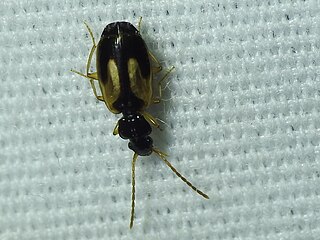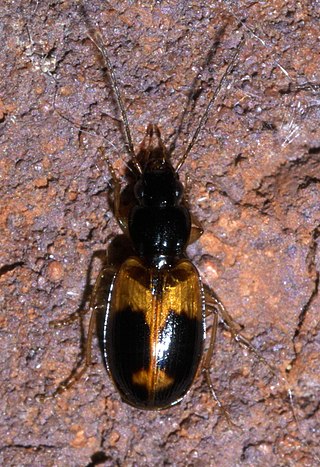
Steller's jay is a bird native to western North America and the mountains of Central America, closely related to the blue jay found in eastern North America. It is the only crested jay west of the Rocky Mountains. It is also sometimes colloquially called a "blue jay" in the Pacific Northwest, but is distinct from the blue jay of eastern North America. The species inhabits pine-oak and coniferous forests.

The orange-crowned warbler is a small songbird of the New World warbler family.

Chlaenius is a large and diverse genus of ground beetle. It is native to the Palearctic realm, Afrotropical realm, and Nearctic realm. Worldwide, roughly 1,000 species are currently recognized with the majority of known species occurring in the Oriental and Afrotropical regions. The genus is divided into many subgenera.
Camptodontornis is an extinct genus of enantiornithine bird which existed in what is now Chaoyang in Liaoning Province, China during the early Cretaceous period. It is known from a well-preserved skeleton including a skull found in the Jiufotang Formation of Liaoning Province. Its original generic name was "Camptodontus" ; it was named by Li Li, En-pu Gong, Li-dong Zhang, Ya-jun Yang and Lian-hai Hou in 2010. However, the name had previously been used for a genus of beetle. The type species is "Camptodontus" yangi. Demirjian (2019) coined a replacement generic name Camptodontornis. The status of C. yangi as a distinct species is disputed, with Wang et al. (2015) considering it to be a probable synonym of Longipteryx chaoyangensis.

Carabinae is a subfamily of ground beetles in the family Carabidae. There are about 10 genera and more than 1,400 described species in Carabinae.
Amblygnathus is a genus in the beetle family Carabidae. There are more than 20 described species in Amblygnathus.

Plochionus is a genus in the beetle family Carabidae. There are about 18 described species in Plochionus.

Axinopalpus is a genus in the beetle family Carabidae, found in North, Central, and South America. There are about 15 described species in Axinopalpus.

Coptodera is a genus of beetles in the family Carabidae, constituted of 105 species distributed across North and South America, Africa, Oceania and eastern Asia.

Licininae is a subfamily of in the beetle family Cicindelidae. There are more than 80 genera and 1,800 described species in Licininae.

Dicaelus is a genus in the beetle family Carabidae. There are about 18 described species in Dicaelus, found in North America.

Chlaenius purpuricollis is a species of ground beetle in the large and diverse genus Chlaenius. It is found in the United States and Canada.

Chlaenius sericeus is a species in the beetle family Carabidae. It is found in the United States and Canada.
Onypterygia is a genus of ground beetles in the family Carabidae. There are more than 30 described species in Onypterygia, found in North, Central, and South America, with the exception of Onypterygia tricolor which is found worldwide.

Scaritinae is a worldwide subfamily of beetles in the family Carabidae, containing more than 2400 species in over 140 genera.

Epomis is a subgenus of ground beetle genus Chlaenius. The larvae of this subgenus are notable for being obligate role-reversal predators. Amphibians such as frogs are normally predators of beetles; however, Epomis larvae feed exclusively on amphibians.
Nebria reichii is a species in the beetle family Carabidae. It is found in Ukraine and Romania.
Pinacodera is a genus in the beetle family Carabidae. There are more than 20 described species in Pinacodera, found in North, Central, and South America.













